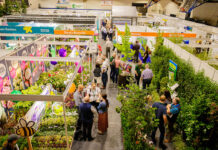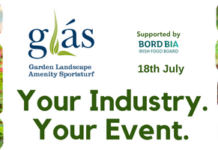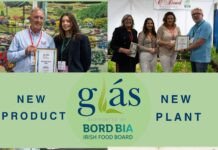We are very sorry to report the passing of Dr. Keith Lamb, who was instrumental in saving many of the apple varieties that we now preserve and propagate at Irish Seed Savers. In the 1940s, Dr Lamb recognised a pattern of destruction in both commercial orchards and private orchards, so he set out to identify, collect, cultivate and save numerous varieties of old Irish apples that were still in private and commercial cultivation in the 1940s. His research turned up 53 varieties of Irish apple. Some like the Irish Peach or the Early Crofton were widely distributed. Others were of a more local character, with particular varieties associated with the North of Ireland, the Midlands and the South of Ireland.
Anita Hayes, founder of ISSA, with Dr. Keith Lamb
Some of the apples he encountered and saved have wonderful, suggestive names like Honey Ball, Greasy Pippin, Lady’s Finger, Maiden’s Blush, and Widow’s Friend. Irish varieties of apples were noted for their resistance to disease, especially canker and scab. In addition they thrived in Irish soils and were well suited to Irish climatic conditions. Today his work continues in two orchards where experts have managed to retrieve and cultivate some of the old varieties identified by Dr. Lamb: Lamb Clark Historic Apple Collection at University College, Dublin, and here at Irish Seed Savers.Without the work of Dr. Lamb many of these old apple varieties would be lost forever.
In the 1990’s Dr. Lamb and Anita Hayes, founder of Irish Seed Savers Association, produced a booklet called The Irish Apple – History and Myth. This is Dr. Lamb’s introduction to the book:
“It was over fifty years ago that I became interested in local varieties of apple trees. With the encouragement of the late Professor G.O. Sherrard I carried out a survey of these old kinds. The results of this survey were published in 1950, in the Economic Proceedings of The Royal Dublin Society. I was fortunate that at that time a horticultural advisory officer was stationed in each county. These officers ha intimate knowledge of the their areas and introduced me to owners of old orchards and of individual trees. Where the same apple was given the same name in different localities I could be confident that such a variety and name was valid. An additional source of verification was wen such a variety was mentioned in the Statistical Surveys of the counties published by the Dublin Society in the early years of the nineteenth century.

Dr. and Mrs. Lamb, and Charlie Robinsonz
With the passage of time I tended to regard that work as largely of historical interest. Then came the realisation in many quarters that we were being left with a dangerously narrow genetic base in our cultivated crops an domestic animals. Characteristics of possible value for incorporation in future breeding were being lost. In apples, for example, many of the old kinds were noted as being free of visible diseases. Indeed in former times if a variety was unhealthy it would be discarded, for these were days before chemical sprays. Irish Peach apple is an exception now, but it may have lost a one time immunity to scab as has the more modern Bramley Seedling.

Lamb-Clark collection inaugerationz
It is evident, therefore, how important is the conservation work being carried out by such organisations as the Irish Seed Savers Association, the Armagh Orchards Trust, the University College, Dublin and their counterparts in other countries. Not only does this preserve plants and animals for our enjoyment but ensures the maintenance of a gene pool for future development. Many of the older varieties of crop plants have characteristics of flavour and texture that are apt to be lost in modern kinds bred to meet the narrow requirements of commercial production.”






